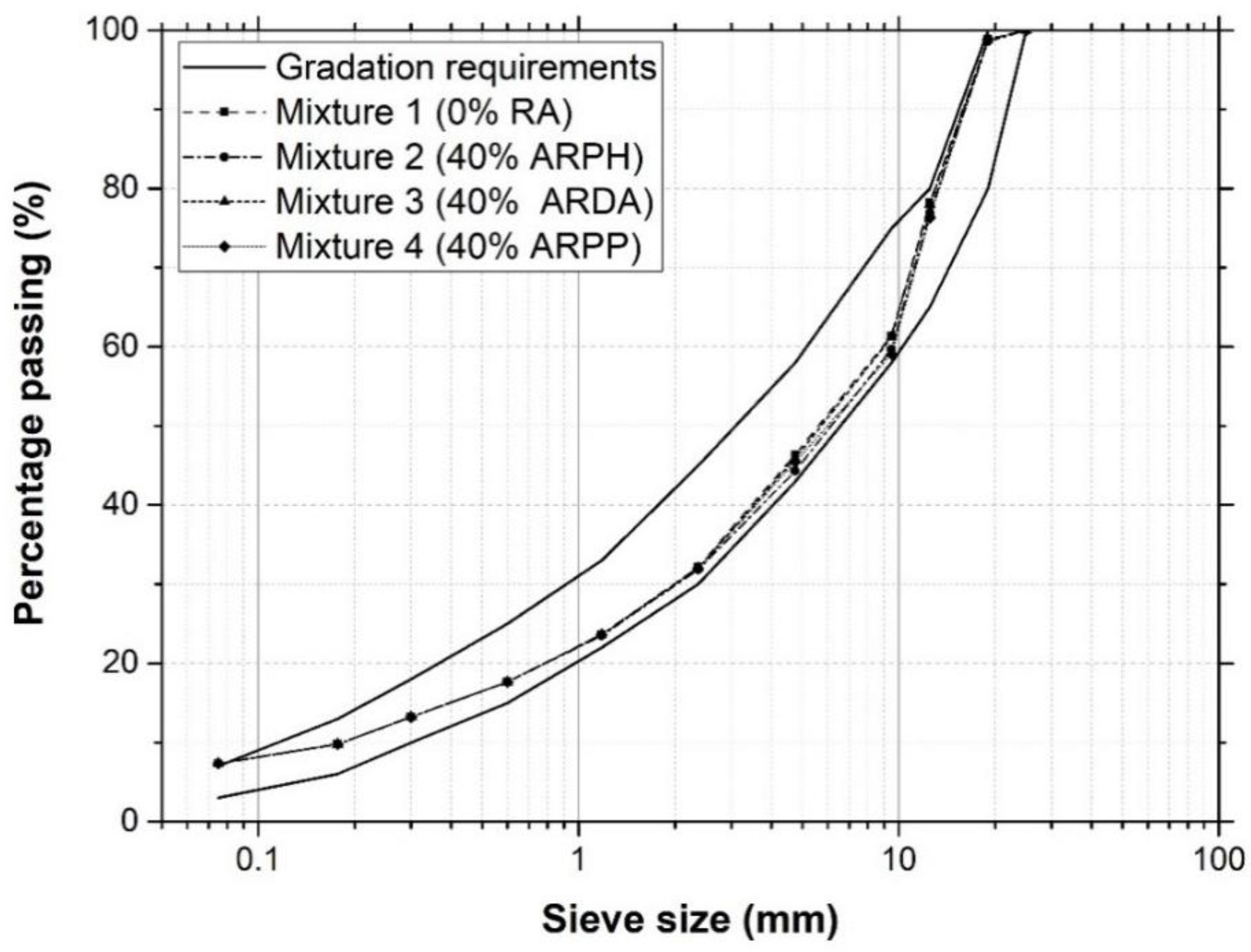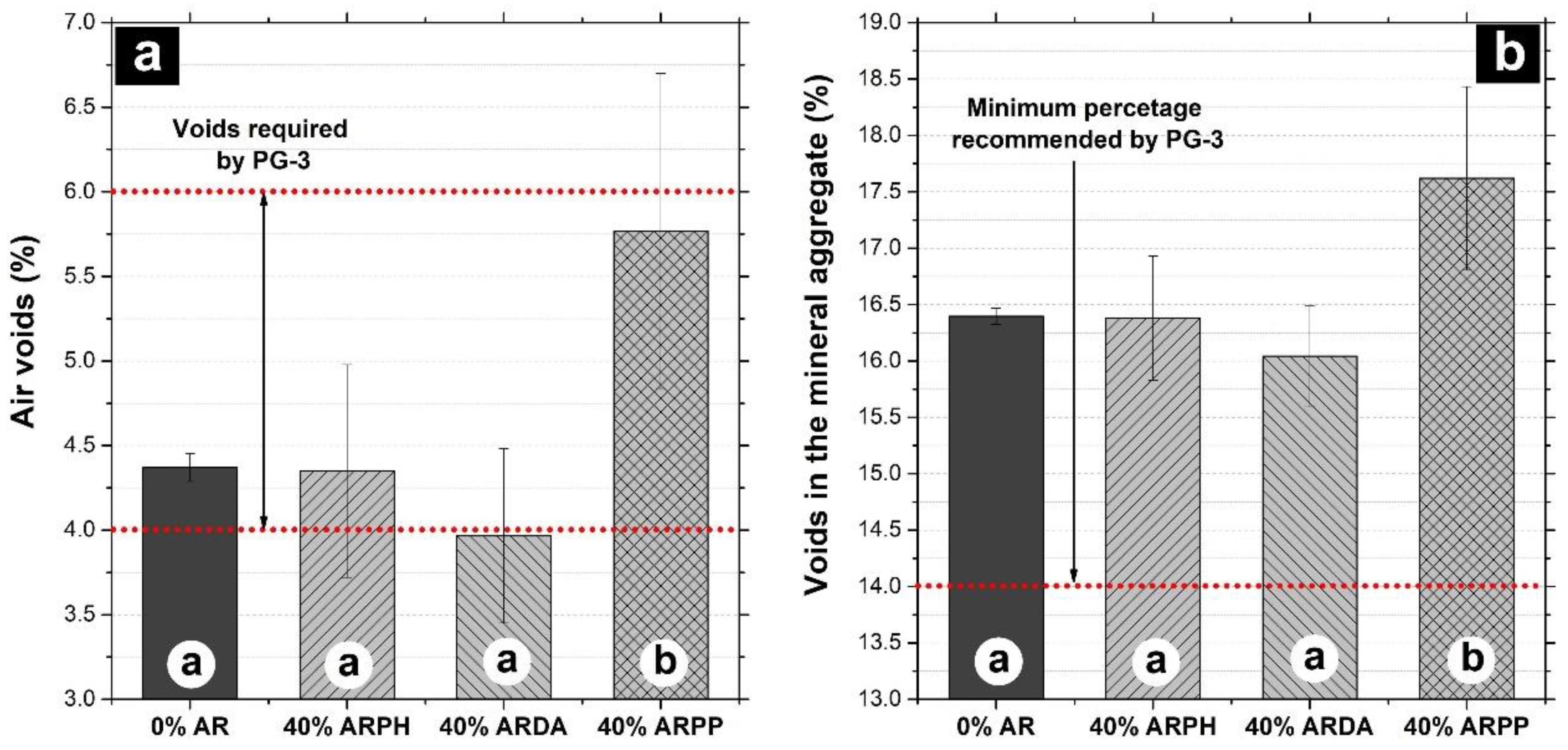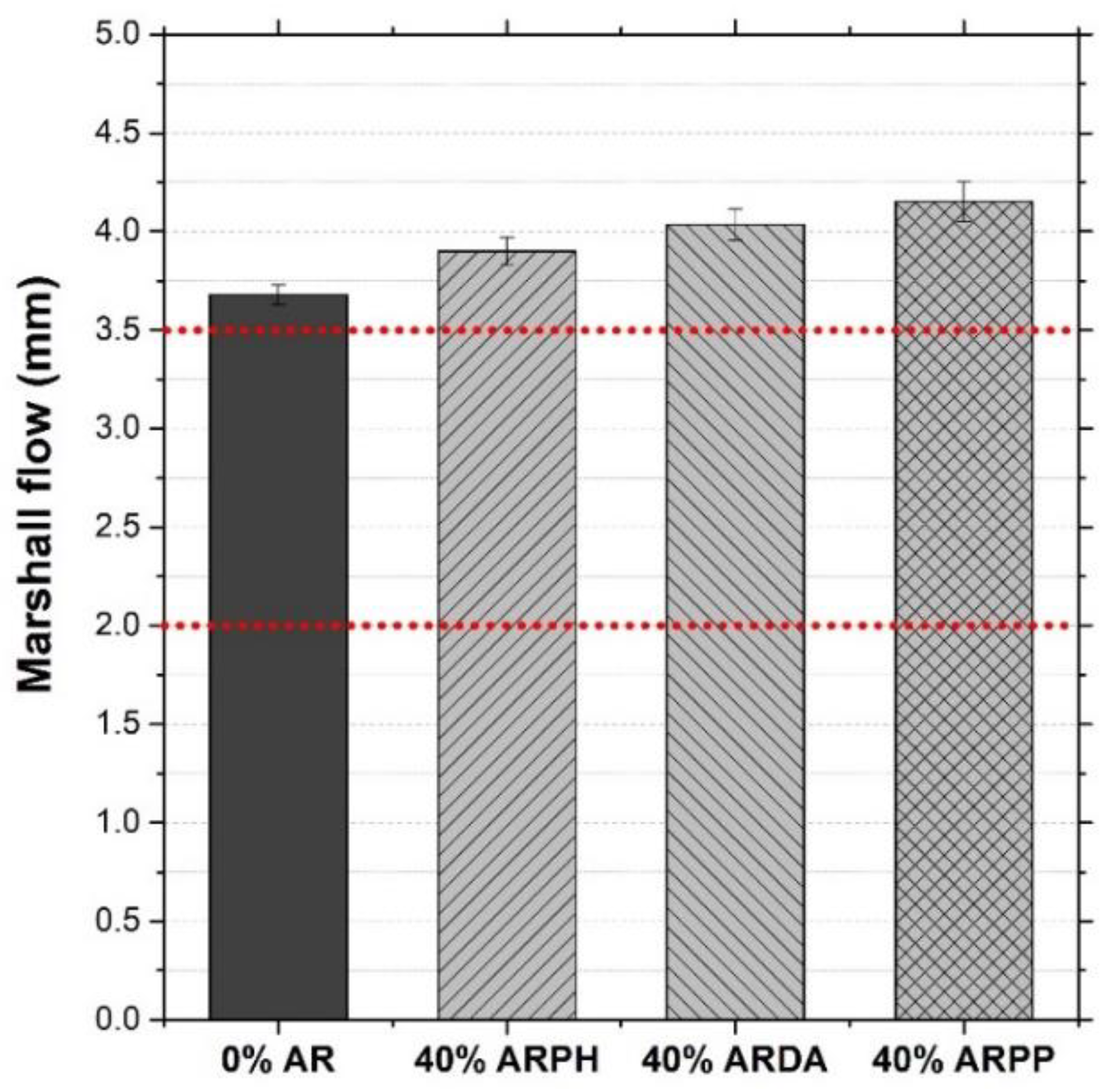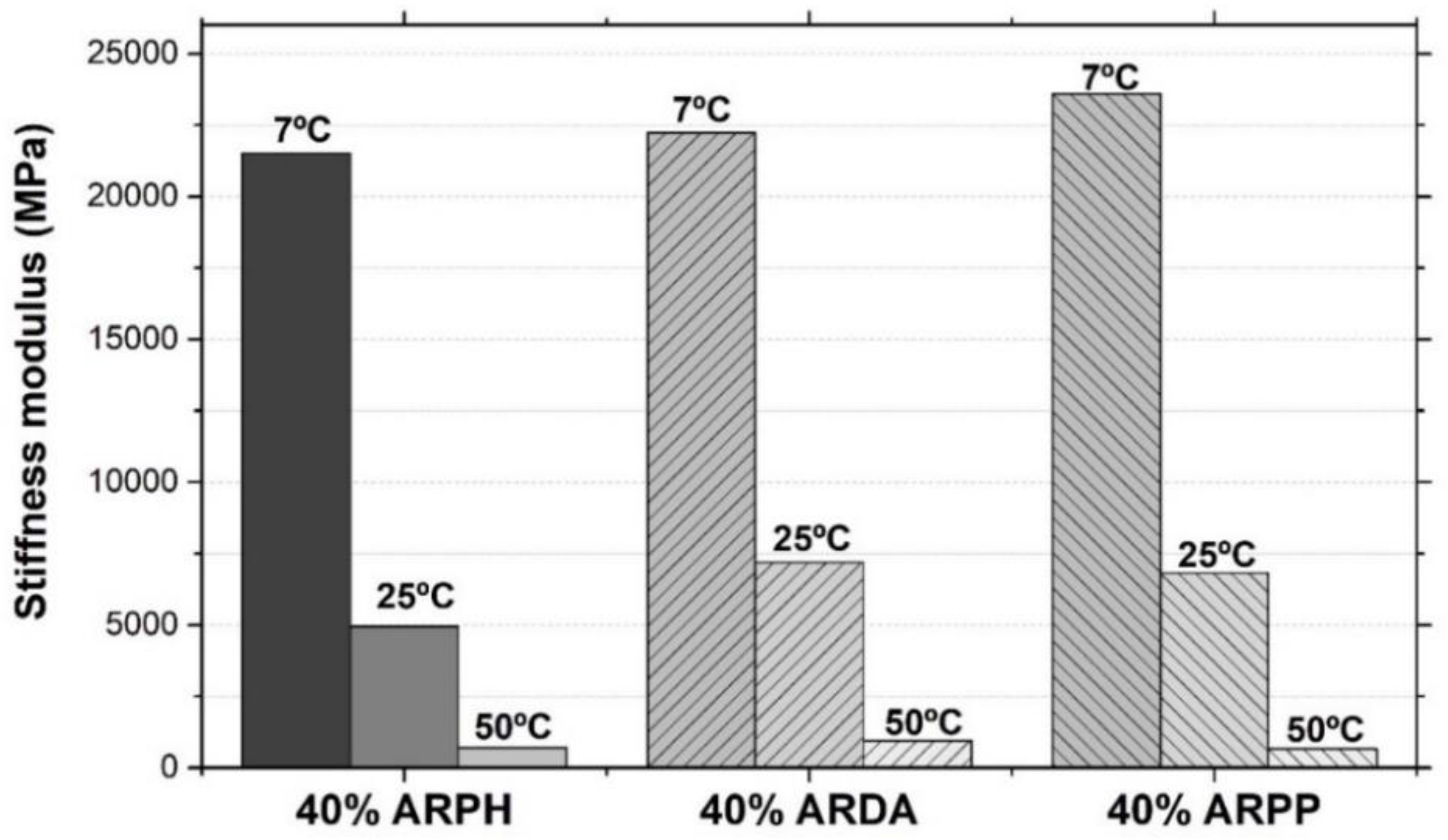Laboratory Evaluation of Hot Asphalt Concrete Properties with Cuban Recycled Concrete Aggregates
Abstract
:1. Introduction
2. Materials and Methods
2.1. Materials
Hot Asphalt Concrete Design
- (a)
- Mixture 1 (0% RA): Conventional mixture with natural aggregates.
- (b)
- Mixture 2 (40% ARPH): Mixture with 40% natural aggregate replacement by CDW of concrete specimens, in 5 to 10 mm fraction.
- (c)
- Mixture 3 (40% ARDA): Mixture with 40% natural aggregate replacement by the Havana sidewalk waste, in 5 to 10 mm fraction.
- (d)
- Mixture 4 (40% ARPP): Mixture with a 40% natural aggregate replacement by waste from Spiroll slab precast plant, in the 5 to 10 mm fraction.
2.2. Experimental Methodology
2.2.1. X-ray Diffraction
2.2.2. Marshall Method
2.2.3. Stiffness Modulus
2.2.4. Statistical Analysis
3. Results and Discussion
3.1. X-Ray Diffraction
3.2. Marshall Analysis
3.3. Stiffness Modulus
3.4. Horizontal Deformation
3.5. Statistical Analysis
4. Conclusions
- (1)
- The main mineral phases observed in the RA were CaCO3 and dolomite. This was due to the origin of the aggregates used to manufacture the original Cuban concrete.
- (2)
- For the same percentage of asphalt, the density and voids of the mixture varied depending on the source of RA origin.
- (3)
- The stability obtained in the RA mixtures is less than the reference stability. However, all the RA mixtures comply with the limits established in PG-3.
- (4)
- The deformation of the mixtures was slightly higher than the deformation of reference mixture.
- (5)
- RA mixtures had a stiffness modulus, even at high temperatures, that was in line with recommendations.
- (6)
- The statistical analysis performed shows that the percentage of RA influenced the physical properties. However, there was no significant influence in the Marshall stability, flow, stiffness and horizontal deformation.
Author Contributions
Funding
Acknowledgments
Conflicts of Interest
References
- Huang, W.L.; Lin, D.H.; Chang, N.B.; Lin, K.S. Recycling of Construction and Demolition Waste via a Mechanical Sorting Process. Resour. Conserv. Recycl. 2002, 37, 23–37. [Google Scholar] [CrossRef]
- Robinson, G.R.; Menzie, W.D.; Hyun, H. Recycling of Construction Debris as Aggregate in the Mid-Atlantic Region, USA. Resour. Conserv. Recycl. 2004, 42, 275–294. [Google Scholar] [CrossRef]
- Tenza-Abril, A.J.; Saval, J.M.; Cuenca, A. Using Sewage-Sludge Ash as Filler in Bituminous Mixes. J. Mater. Civ. Eng. 2015, 27. [Google Scholar] [CrossRef]
- Shi, C.; Li, Y.; Zhang, J.; Li, W.; Chong, L.; Xie, Z. Performance Enhancement of Recycled Concrete Aggregate—A Review. J. Clean. Prod. 2016, 112, 466–472. [Google Scholar] [CrossRef]
- Pérez, I.; Pasandín, A.R.; Medina, L. Hot Mix Asphalt Using C&D Waste as Coarse Aggregates. Mater. Des. 2012, 36, 840–846. [Google Scholar] [CrossRef]
- Zhu, J.; Wu, S.; Zhong, J.; Wang, D. Investigation of Asphalt Mixture Containing Demolition Waste Obtained from Earthquake-Damaged Buildings. Constr. Build. Mater. 2012, 29, 466–475. [Google Scholar] [CrossRef]
- Huang, Y.; Bird, R.N.; Heidrich, O. A Review of the Use of Recycled Solid Waste Materials in Asphalt Pavements. Resour. Conserv. Recycl. 2007, 52, 58–73. [Google Scholar] [CrossRef]
- Pavón, E.; Martínez, I.; Etxeberria, M. The Production of Construction and Demolition Waste Material and the Use of Recycled Aggregates in Havana, Cuba. Rev. Fac. Ing. Univ. Antioq. 2014, 71, 167–178. [Google Scholar]
- Martínez, I.; Etxeberria, M.; Pavón, E.; Díaz, N. A Comparative Analysis of the Properties of Recycled and Natural Aggregate in Masonry Mortars. Constr. Build. Mater. 2013, 49, 384–392. [Google Scholar] [CrossRef]
- Arabani, M.; Azarhoosh, A.R. The Effect of Recycled Concrete Aggregate and Steel Slag on the Dynamic Properties of Asphalt Mixtures. Constr. Build. Mater. 2012, 35, 1–7. [Google Scholar] [CrossRef]
- Pasandín, A.R.; Pérez, I. Laboratory Evaluation of Hot-Mix Asphalt Containing Construction and Demolition Waste. Constr. Build. Mater. 2013, 43, 497–505. [Google Scholar] [CrossRef]
- Mills-Beale, J.; You, Z. The Mechanical Properties of Asphalt Mixtures with Recycled Concrete Aggregates. Constr. Build. Mater. 2010, 24, 230–235. [Google Scholar] [CrossRef]
- Pasandín, A.R.; Pérez, I. Mechanical Properties of Hot-Mix Asphalt made with Recycled Concrete Aggregates Coated with Bitumen Emulsion. Constr. Build. Mater. 2014, 55, 350–358. [Google Scholar] [CrossRef]
- Ossa, A.; García, J.L.; Botero, E. Use of Recycled Construction and Demolition Waste (CDW) Aggregates: A Sustainable Alternative for the Pavement Construction Industry. J. Clean. Prod. 2016, 135, 379–386. [Google Scholar] [CrossRef]
- Evangelista, L.; De Brito, J. Concrete with Fine Recycled Aggregates: A Review. Eur. J. Environ. Civ. Eng. 2014, 18, 129–172. [Google Scholar] [CrossRef]
- Pasandín, A.R. Sensibilidad al Agua y Propiedades Mecánicas de Mezclas Bituminosas en Caliente Fabricadas con áridos Reciclados de Residuos de Construcción y Demolición, Escuela Técnica Superior de Ingenieros de Caminos, Canales y Puertos; Universidade da Coruña: A Coruña, Spain, 2013. [Google Scholar]
- Alexandridou, C.; Angelopoulos, G.N.; Coutelieris, F.A. Mechanical and Durability Performance of Concrete Produced with Recycled Aggregates from Greek Construction and Demolition Waste Plants. J. Clean. Prod. 2018, 176, 745–757. [Google Scholar] [CrossRef]
- Paranavithana, S.; Mohajerani, A. Effects of Recycled Concrete Aggregates on Properties of Asphalt Concrete. Resour. Conserv. Recycl. 2006, 48, 1–12. [Google Scholar] [CrossRef]
- Tam, V.W.Y.; Gao, X.F.; Tam, C.M. Microstructural Analysis of Recycled Aggregate Concrete Produced from Two-Stage Mixing Approach. Cem. Concr. Res. 2005, 35, 1195–1203. [Google Scholar] [CrossRef]
- Colangelo, F.; Cioffi, R. Mechanical Properties and Durability of Mortar Containing Fine Fraction of Demolition Wastes Produced by Selective Demolition in South Italy. Compos. Part B Eng. 2017, 115, 43–50. [Google Scholar] [CrossRef]
- Colangelo, F.; Petrillo, A.; Cioffi, R.; Borrelli, C.; Forcina, A. Life Cycle Assessment of Recycled Concretes: A Case Study in Southern Italy. Sci. Total Environ. 2018, 615, 1506–1517. [Google Scholar] [CrossRef] [PubMed]
- Kim, Y.; Hanif, A.; Kazmi, S.M.S.; Munir, M.J.; Park, C. Properties Enhancement of Recycled Aggregate Concrete through Pretreatment of Coarse Aggregates—Comparative Assessment of Assorted Techniques. J. Clean. Prod. 2018, 191, 339–349. [Google Scholar] [CrossRef]
- Vazquez Ramonich, E.; Barra, M.; Moreno Lasalle, L.; Sopena Canals, F.J.; Valero López, I.; Rebollo Pericot, J.; Andreu, T.; Balmaceda, A. Aportación de árido reciclado mixto con predominio de hormigón para la sustitución de parte del árido fino en la fabricación de mezclas bituminosas. In VII Jornada Nacional de ASEFMA; ASEFMA: Madrid, Spain, 2012; p. 8. [Google Scholar]
- Al-Baiti, H.K.; Al-Sarrag, N.I.; Saleh Al-maliky, S.E. Use of Recycling Building Demolition waste As Coarse Aggregate in Hot Mix Asphalt. Tikrit J. Eng. Sci. 2014, 21, 63–76. [Google Scholar]
- Wong, Y.D.; Sun, D.D.; Lai, D. Value-added Utilisation of Recycled Concrete in Hot-Mix Asphalt. Waste Manag. 2007, 27, 294–301. [Google Scholar] [CrossRef] [PubMed]
- Asociación Española de Normalización y Certificación. UNE-EN 13043: Áridos para Mezclas Bituminosas y Tratamientos Superficiales de Carreteras, Aeropuertos y Otras Zonas Pavimentadas; AENOR: Madrid, Spain, 2003. [Google Scholar]
- Asociación Española de Normalización y Certificación. UNE-EN 12591: Betunes y Ligantes Bituminosos. Especificaciones de Betunes para Pavimentación; AENOR: Madrid, Spain, 2009. [Google Scholar]
- De Juan, M.S.; Gutiérrez, P.A. Study on the Influence of Attached Mortar Content on the Properties of Recycled Concrete Aggregate. Constr. Build. Mater. 2009, 23, 872–877. [Google Scholar] [CrossRef]
- Asociación Española de Normalización y Certificación. UNE-EN 1097-6: Ensayos Para Determinación las Propiedades Mecánicas y físicas de los áridos. Parte 6: Determinación de la Densidad de Partículas y la Absorción de Agua; AENOR: Madrid, Spain, 2001. [Google Scholar]
- Asociación Española de Normalización y Certificación. UNE-EN 12697-34: Mezclas Bituminosas. Métodos de Ensayo para Mezcla Bituminosa en Caliente. Parte 34: Ensayo Marshall; AENOR: Madrid, Spain, 2006. [Google Scholar]
- Oficina Nacional de Normalización. NC 253 Carreteras. Materiales Bituminosos. Hormigón Asfáltico Caliente. Especificaciones; Oficina Nacional de Normalización: La Habana, Cuba, 2005. [Google Scholar]
- Christopher, W.J.; Crawford, F.J.; Edward, T.H.; Adock, M.; Delaney, E.P.; Freer, H. A Manual for Design of Hot Mix Asphalt with Commentary. NCHRP Report No. 673; National Academies Press: Washington, DC, USA, 2011; ISBN 9780309155649. [Google Scholar]
- Asociación Española de Normalización y Certificación. UNE-EN 12697-26: Métodos de Ensayo para Mezcla Bituminosa en Caliente. Parte 26: Rigidez; AENOR: Madrid, Spain, 2005. [Google Scholar]
- Blanco, M.T.; Puertas, F.; Vázquez, T.; de la Fuente, A. The Most Suitable Techiniques and Methods to Identify High Alumina Cement and Based Portland Cement in Concretes. Mater. Constr. 1992, 42, 51–64. [Google Scholar] [CrossRef]
- Pérez, I.; Toledano, M.; Gallego, J.; Taibo, J. Mechanical Properties of Hot Mix Asphalt Made with Recycled Aggregates from Reclaimed Construction and Demolition Debris. Mater. Constr. 2007, 57, 17–29. [Google Scholar] [CrossRef]
- Ministerio de Fomento. Pliego de Prescripciones Técnicas Generales para Obras de Carreteras y Puentes (PG-3); Dirección General de Carreteras, Ministerio de Fomento, Ed.; Ministerio de Fomento: Madrid, Spain, 2015. [Google Scholar]
- Alonso Aenlle, A. Obtención a Nivel de Laboratorio de una Mezcla Asfáltica Semicaliente a Partir de la Utilización de Zeolita Natural Cubana del Yacimiento de Tasajeras; CUJAE, Instituto Superior Politécnico José Antonio Echeverría, Facultad de Ingeniería Civil: Havana, Cuba, 2012. [Google Scholar]
- Generalitat Valenciana. Norma de Secciones de Firmes de la Comunidad Valenciana; Conselleria d’Infraestructures i Transport; Generalitat Valenciana: Valencia, Spain, 2009. [Google Scholar]
- Alonso, A.; Tejeda, E.; Moreno, F.; Rubio, M.C.; Medel, E. A Comparative Study of Natural Zeolite and Synthetic Zeolite as an Additive in Warm Asphalt Mixes. Mater. Constr. 2013, 63, 195–217. [Google Scholar] [CrossRef]










| Chemical Composition (%) | |||
|---|---|---|---|
| ARPH | ARDA | ARPP | |
| Na2O | 0.59 | 0.60 | 0.26 |
| MgO | 2.50 | 4.00 | 6.12 |
| Al2O3 | 3.90 | 3.19 | 1.38 |
| SiO2 | 15.30 | 13.35 | 5.98 |
| SO3 | 0.47 | 0.74 | 0.50 |
| K2O | 0.46 | 0.39 | 0.22 |
| CaO | 36.64 | 34.13 | 39.09 |
| Fe2O3 | 2.10 | 1.37 | 0.76 |
| L.O.I. 1 | 37.31 | 41.72 | 45.37 |
| Properties | Natural Aggregate | Recycled Aggregates | ||||
|---|---|---|---|---|---|---|
| (10–19 mm) | (10–5 mm) | (0–5 mm) | ARPH (5–10 mm) | ARDA (5–10 mm) | ARPP (5–10 mm) | |
| Effective Specific Gravity (kg/cm3) | 2654 | 2597 | 2672 | 2373 | 2422 | 2200 |
| Apparent specific gravity (kg/cm3) | 2696 | 2683 | 2777 | 2657 | 2635 | 2657 |
| Water absorption at 24 h (%) | 0.583 | 1.23 | 1.4 | 7.80 | 5.68 | 4.95 |
| Properties | Standard | Values | Requirements |
|---|---|---|---|
| Penetration (100 g, 25 °C, 5 seg) (1/10 mm) | UNE EN 1426 | 58.23 | 50–70 |
| Softening point (°C) | UNE EN 1427 | 51 | 4–54 |
| Flash and fire point (°C) Cleveland cup | UNE EN 22592 | 290 | >230 |
| Specific gravity (g/cm3) | ISO 3830 | 1.043 | >1.00 |
| Loss-on-Ignition (%) | UNE EN 12607 | 0.46 | <0.5 |
| Percentage of penetration after loss (%) | UNE EN 1427 | 57.7 | >50 |
| Proportions | 0% RA | 40% ARPH | 40% ARDA | 40% ARPP |
|---|---|---|---|---|
| 0–5 mm | 45 | 45 | 45 | 45 |
| 5–10 mm | 17 | 10 | 10 | 10 |
| 10–20 mm | 38 | 38 | 38 | 38 |
| ARPH (5–10 mm) | - | 7 | - | - |
| ARDA (5–10 mm) | - | - | 7 | - |
| ARPP (5–10 mm) | - | - | - | 7 |
| Parameter | DF 1 | Sum of Squares | Mean Square | F Value | p Value 2 | |
|---|---|---|---|---|---|---|
| Bulk density | Model | 3 | 0.00594 | 0.00198 | 10.35732 | 0.0005 |
| Error | 16 | 0.00306 | 1.9112 × 10−4 | |||
| Total | 19 | 0.009 | ||||
| Stability | Model | 3 | 0.48675 | 0.16225 | 1.15271 | 0.455 |
| Error | 3 | 0.4226 | 0.14075 | |||
| Total | 6 | 0.90901 | ||||
| Marshall flow | Model | 3 | 0.16664 | 0.05555 | 3.23879 | 0.180 |
| Error | 3 | 0.05145 | 0.01715 | |||
| Total | 6 | 0.21809 | ||||
| Stiffness | Model | 2 | 2.86591 × 106 | 1.43296 × 106 | 0.01126 | 0.989 |
| Error | 6 | 7.63358 × 108 | 1.27226 × 108 | |||
| Total | 8 | 7.66224 × 108 | ||||
| Horizontal deformation | Model | 2 | 4.7538 | 2.3769 | 0.50604 | 0.626 |
| Error | 6 | 28.1826 | 4.6971 | |||
| Total | 8 | 32.9364 | ||||
© 2018 by the authors. Licensee MDPI, Basel, Switzerland. This article is an open access article distributed under the terms and conditions of the Creative Commons Attribution (CC BY) license (http://creativecommons.org/licenses/by/4.0/).
Share and Cite
Acosta Alvarez, D.; Alonso Aenlle, A.; Tenza-Abril, A.J. Laboratory Evaluation of Hot Asphalt Concrete Properties with Cuban Recycled Concrete Aggregates. Sustainability 2018, 10, 2590. https://doi.org/10.3390/su10082590
Acosta Alvarez D, Alonso Aenlle A, Tenza-Abril AJ. Laboratory Evaluation of Hot Asphalt Concrete Properties with Cuban Recycled Concrete Aggregates. Sustainability. 2018; 10(8):2590. https://doi.org/10.3390/su10082590
Chicago/Turabian StyleAcosta Alvarez, Debora, Anadelys Alonso Aenlle, and Antonio José Tenza-Abril. 2018. "Laboratory Evaluation of Hot Asphalt Concrete Properties with Cuban Recycled Concrete Aggregates" Sustainability 10, no. 8: 2590. https://doi.org/10.3390/su10082590
APA StyleAcosta Alvarez, D., Alonso Aenlle, A., & Tenza-Abril, A. J. (2018). Laboratory Evaluation of Hot Asphalt Concrete Properties with Cuban Recycled Concrete Aggregates. Sustainability, 10(8), 2590. https://doi.org/10.3390/su10082590






